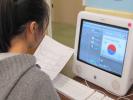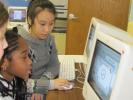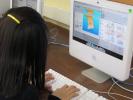Making Connections with Scratch: An Interview with Lorraine Leo of Jackson School
Most educators discover lesson plan ideas outside of the classroom – while talking to colleagues, consulting curriculum guides, or searching online resources. Lorraine Leo looks a bit further. A K-6 educator at Jackson School in Newton, Massachusetts, Lorraine’s curriculum is inspired by different cultures from around the world.
“I just take something from the real world and try to translate it.”
Lorraine first started bringing outside material into her classroom through the voyages of Skipper Rich Wilson, a sailor who connects his live expeditions to K-12 classrooms via the web. “As he was sailing, I was connecting my kids to what he was doing. It integrated all kinds of technology from Google Maps to telecommunications. We followed him on his sitesALIVE! web site from New York to Melbourne, Hong Kong to New York and in the Vendee Globe. And that’s how I started making connections with people in different parts of the world.”
As she met like-minded educators from across the globe, Lorraine began collaborating with them to discover more of Scratch’s potential in the classroom. For example, Lorraine has worked with Yoshiro Miyata from Chukyo University in Toyota, Japan for the past two years. Yoshiro’s university students and Lorraine’s elementary students remix each other’s projects, letting Scratch blocks function as a universal form of communication. The two educators also enjoy working together on coordinating international Scratch Day events each year. Lorraine has established similar relationships with teachers in Russia, China, Japan, and the Philippines. The educators support one another to learn more about Scratch, while at the same time, the students gain greater awareness of a global audience. “The children like sharing their projects with the rest of the world.”
Last year, students from South Korea paid a visit to Lorraine’s classroom. Side by side with Jackson School students, the children worked in pairs using Scratch to create interactive slideshows about Korean culture. For Lorraine, group work was the key to overcoming the language barrier. “I knew I had to teach the visiting students something in the classroom at the same time as teach my students, and I wanted something they could all do and collaborate on. They asked each other questions about their food and language, and we practiced creating audio files of the students to put into their Scratch projects.”
Some of Lorraine’s lesson plans cross curricular disciplines as well as cultural boundaries. “I was observing a math class today and they were doing rotations and reflections. I’m sure there are ways of illustrating that in Scratch.” Prompted by the Discovery space shuttle launch, Lorraine challenged her students to create a Scratch project with a rocket rotating around a globe. “When I go to the music class concert, I’ll record an mp3 that the students then use in Scratch. And the art teacher likes the idea of incorporating art. I just think about what other teachers are doing in their classrooms and what I’m doing.”
Lorraine encourages this cooperative spirit in her students as well. She talks about her classroom as a collective “we,” where everyone is a student, including herself. “Just listening to what the kids say, I learn from them. I get very excited when I finally understand something because they’re explaining it to me in a way that I understand. Sometimes at night I’ll go through their projects and find myself remixing them just for fun. There is a student who is taking off with Scratch on his own. Now I go to him when I have a question.”
Building an environment of mutual respect for learning and exploration, Lorraine supports students to find resources and connections, but doesn’t expect to have all the answers. “I don’t feel like an expert in the classroom. If someone comes to me and says, ‘I don’t understand that,’ I don’t say, ‘Oh no. That’s page 3 and we’re on page 2.’ I’ll say, ‘You know, you’re the first person that has ever done this and I’m not sure how we’re going to do it either.’ I do have structure, but it’s a bit more open-ended in how it looks in the end. I let them take it to a level that is undefined. So maybe the ceiling is not where it was originally. I’m letting them go a bit further.”




